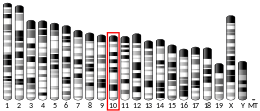FZR1
Fizzy-related protein homolog, also known as hCDH1, is a protein that in humans is encoded by the FZR1 gene.[5][6][7][8]
Interactions
FZR1 has been shown to interact with CDC27[9][10] and FBXO5.[11]
gollark: Troubling./
gollark: Most of the time I don't find something with DDG I also don't find it with Google, so meh.
gollark: The browser omnibox, I mean.
gollark: Besides, I always just type into my search bar directly.
gollark: These are basically identical functionally. And æsthetically.
References
- GRCh38: Ensembl release 89: ENSG00000105325 - Ensembl, May 2017
- GRCm38: Ensembl release 89: ENSMUSG00000020235 - Ensembl, May 2017
- "Human PubMed Reference:". National Center for Biotechnology Information, U.S. National Library of Medicine.
- "Mouse PubMed Reference:". National Center for Biotechnology Information, U.S. National Library of Medicine.
- Kramer, Edgar R.; Gieffers, Christian; Hölzl, Gabriele; Hengstschläger, Markus; Peters, Jan-Michael (1998-11-05). "Activation of the human anaphase-promoting complex by proteins of the CDC20/Fizzy family". Current Biology. 8 (22): 1207–S4. doi:10.1016/S0960-9822(07)00510-6. ISSN 0960-9822. PMID 9811605.
- Fang G, Yu H, Kirschner MW (August 1998). "Direct binding of CDC20 protein family members activates the anaphase-promoting complex in mitosis and G1". Molecular Cell. 2 (2): 163–71. doi:10.1016/S1097-2765(00)80126-4. PMID 9734353.
- Sorensen CS, Lukas C, Kramer ER, Peters JM, Bartek J, Lukas J (October 2000). "Nonperiodic activity of the human anaphase-promoting complex-Cdh1 ubiquitin ligase results in continuous DNA synthesis uncoupled from mitosis". Molecular and Cellular Biology. 20 (20): 7613–23. doi:10.1128/MCB.20.20.7613-7623.2000. PMC 86321. PMID 11003657.
- "Entrez Gene: FZR1 fizzy/cell division cycle 20 related 1 (Drosophila)".
- Zhou Y, Ching YP, Ng RW, Jin DY (September 2003). "Differential expression, localization and activity of two alternatively spliced isoforms of human APC regulator CDH1". The Biochemical Journal. 374 (Pt 2): 349–58. doi:10.1042/BJ20030600. PMC 1223613. PMID 12797865.
- Kramer ER, Gieffers C, Hölzl G, Hengstschläger M, Peters JM (November 1998). "Activation of the human anaphase-promoting complex by proteins of the CDC20/Fizzy family". Current Biology. 8 (22): 1207–10. doi:10.1016/S0960-9822(07)00510-6. PMID 9811605.
- Hsu JY, Reimann JD, Sørensen CS, Lukas J, Jackson PK (May 2002). "E2F-dependent accumulation of hEmi1 regulates S phase entry by inhibiting APC(Cdh1)". Nature Cell Biology. 4 (5): 358–66. doi:10.1038/ncb785. PMID 11988738.
Further reading
- Kramer ER, Gieffers C, Hölzl G, Hengstschläger M, Peters JM (November 1998). "Activation of the human anaphase-promoting complex by proteins of the CDC20/Fizzy family". Current Biology. 8 (22): 1207–10. doi:10.1016/S0960-9822(07)00510-6. PMID 9811605.
- Gieffers C, Peters BH, Kramer ER, Dotti CG, Peters JM (September 1999). "Expression of the CDH1-associated form of the anaphase-promoting complex in postmitotic neurons". Proceedings of the National Academy of Sciences of the United States of America. 96 (20): 11317–22. Bibcode:1999PNAS...9611317G. doi:10.1073/pnas.96.20.11317. PMC 18031. PMID 10500174.
- Nagase T, Ishikawa K, Kikuno R, Hirosawa M, Nomura N, Ohara O (October 1999). "Prediction of the coding sequences of unidentified human genes. XV. The complete sequences of 100 new cDNA clones from brain which code for large proteins in vitro". DNA Research. 6 (5): 337–45. doi:10.1093/dnares/6.5.337. PMID 10574462.
- Bembenek J, Yu H (December 2001). "Regulation of the anaphase-promoting complex by the dual specificity phosphatase human Cdc14a". The Journal of Biological Chemistry. 276 (51): 48237–42. doi:10.1074/jbc.M108126200. PMID 11598127.
- Stroschein SL, Bonni S, Wrana JL, Luo K (November 2001). "Smad3 recruits the anaphase-promoting complex for ubiquitination and degradation of SnoN". Genes & Development. 15 (21): 2822–36. doi:10.1101/gad.912901 (inactive 2020-05-21). PMC 312804. PMID 11691834.
- Hsu JY, Reimann JD, Sørensen CS, Lukas J, Jackson PK (May 2002). "E2F-dependent accumulation of hEmi1 regulates S phase entry by inhibiting APC(Cdh1)". Nature Cell Biology. 4 (5): 358–66. doi:10.1038/ncb785. PMID 11988738.
- Zur A, Brandeis M (September 2002). "Timing of APC/C substrate degradation is determined by fzy/fzr specificity of destruction boxes". The EMBO Journal. 21 (17): 4500–10. doi:10.1093/emboj/cdf452. PMC 126191. PMID 12198152.
- Zhou Y, Ching YP, Chun AC, Jin DY (April 2003). "Nuclear localization of the cell cycle regulator CDH1 and its regulation by phosphorylation". The Journal of Biological Chemistry. 278 (14): 12530–6. doi:10.1074/jbc.M212853200. PMID 12560341.
- Zhou Y, Ching YP, Ng RW, Jin DY (September 2003). "Differential expression, localization and activity of two alternatively spliced isoforms of human APC regulator CDH1". The Biochemical Journal. 374 (Pt 2): 349–58. doi:10.1042/BJ20030600. PMC 1223613. PMID 12797865.
- Vodermaier HC, Gieffers C, Maurer-Stroh S, Eisenhaber F, Peters JM (September 2003). "TPR subunits of the anaphase-promoting complex mediate binding to the activator protein CDH1". Current Biology. 13 (17): 1459–68. doi:10.1016/S0960-9822(03)00581-5. PMID 12956947.
- Wei W, Ayad NG, Wan Y, Zhang GJ, Kirschner MW, Kaelin WG (March 2004). "Degradation of the SCF component Skp2 in cell-cycle phase G1 by the anaphase-promoting complex". Nature. 428 (6979): 194–8. Bibcode:2004Natur.428..194W. doi:10.1038/nature02381. PMID 15014503.
- Listovsky T, Oren YS, Yudkovsky Y, Mahbubani HM, Weiss AM, Lebendiker M, Brandeis M (April 2004). "Mammalian Cdh1/Fzr mediates its own degradation". The EMBO Journal. 23 (7): 1619–26. doi:10.1038/sj.emboj.7600149. PMC 391060. PMID 15029244.
- Nourry C, Maksumova L, Pang M, Liu X, Wang T (May 2004). "Direct interaction between Smad3, APC10, CDH1 and HEF1 in proteasomal degradation of HEF1". BMC Cell Biology. 5: 20. doi:10.1186/1471-2121-5-20. PMC 420458. PMID 15144564.
- Kraft C, Vodermaier HC, Maurer-Stroh S, Eisenhaber F, Peters JM (May 2005). "The WD40 propeller domain of Cdh1 functions as a destruction box receptor for APC/C substrates". Molecular Cell. 18 (5): 543–53. doi:10.1016/j.molcel.2005.04.023. PMID 15916961.
External links
This article is issued from Wikipedia. The text is licensed under Creative Commons - Attribution - Sharealike. Additional terms may apply for the media files.






